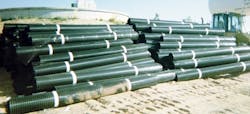Take Me Home
Rural roads are not usually thought of as being highly trafficked, but in a remote area in northern Utah, exploration for gas and oil has brought not only more traffic, but also heavy construction vehicles that cut into the roads. In order to stabilize the base course, biaxially oriented geogrid was used during the rebuilding of Bluebell Road, one of the main roads that runs through Bluebell, Utah.
The Geogrid
BX124GG biaxial geogrid from Advanced Drainage Systems Inc. (ADS) was used in addition to the company’s corrugated high-density polyethylene (HDPE) pipe, which was installed at culvert crossings to handle storm water runoff along the road.
“Originally, a triaxial geogrid was specified for this job, but it really didn’t offer any added performance criteria for this particular job,” said Derek Von Cannon, national geosynthetics product manager for ADS. “We were able to provide the contractor with an increased cost savings by using ADS biaxial geogrid. It also made it possible for the thickness of the base course and the asphalt to be reduced, offering cost savings on roadway design projects. This is a two-lane county road that really gets a lot of abuse due to freeze-thaw cycles and a heavier volume of traffic than you would expect in this rural area. Trucks and construction equipment have really beaten up the surface—a result of volume, weight and speed. [This geogrid] will really improve the longevity of this new road. It is made from polypropylene using punched-and-drawn technology, which provides strength and long-term performance, plus it’s easy to install.”
Approximately 138,000 sq yd of the geogrid was used, with the grid laid width-wise on both sides of the road in some areas. ADS N-12 corrugated HDPE pipe was used in culverts and cross drains for storm water drainage.
“The engineered grid pattern of this geogrid is the key to its load-bearing strength and support,” said Jim Clemans, vice president of allied products for ADS. “Interlocking this pattern with fill—whether it is soil, gravel or rock—produces a superior load transfer, which provides security for a project. It has excellent tensile strength, [making] this geogrid ideal for applications such as base reinforcement and soil stabilization.”
The six versions of BX Series biaxial geogrid each are designed for soil stabilization, base reinforcement and subgrade improvement for road reinforcement, parking lots and airport runways where stresses are in two directions.
Bluebell
Residents and local construction workers rely on the east-west road, which runs in front of the Bluebell Store (the town’s main shopping establishment) and is the main street for the town, which has a population of just under 300. The grid offers a stabilization factor to provide better support for the base course.
“When constructing a road, you’re building it up with different layers of material,” Von Cannon said. “When groundwater rises and falls, there can be soft spots. And here you’re in a climate with wide temperature variations—during the winter, it’s extremely cold with lots of snow, and in the spring, there’s a lot of rain, moisture and high groundwater when the snow is melting. This takes a toll on roadways, as well as the material underneath the pavement, which has been used to build up and stabilize the road because it’s really just a bridge deck and surface area.”
In addition, this particular section of Utah is a high natural-gas-producing area, so there is a lot of heavy equipment driving around on the area roads.
“With these extreme loads, the geogrid is a way to strengthen the foundation of the road so that the pavement lasts longer and there are fewer problems in the long term with freeze-thaw,” Von Cannon said. “When the material underneath the pavement deteriorates, it causes the city or the county to go back and repair those roads with overlays and patches. So geogrid is a way to provide an increased reinforcement of the base course as they construct that road to make it better. Also, while adding geogrid to a road is not going to reduce washout, it will enable the road to fight it better.”
Geosynthetics generally are used on major roads and are financed by a large tax base plus state and federal funds.
“Rural roads, by comparison, do not have a lot of vehicle traffic and are in areas with small populations, and therefore usually are the last to be fixed and have limited budgets allocated by the small communities,” said Tori Durliat, director of marketing for ADS. “But we’re seeing changes. Large sections of the country that are desolate and had just spotty local traffic now are the main path to exploration areas. Now that local government serving a small community is faced with repairing roads that are being eaten away by convoys of large speeding trucks. The use of geogrid will help to repair the road within budget and provide the strength to withstand this new traffic for many years.”
Download: Here


